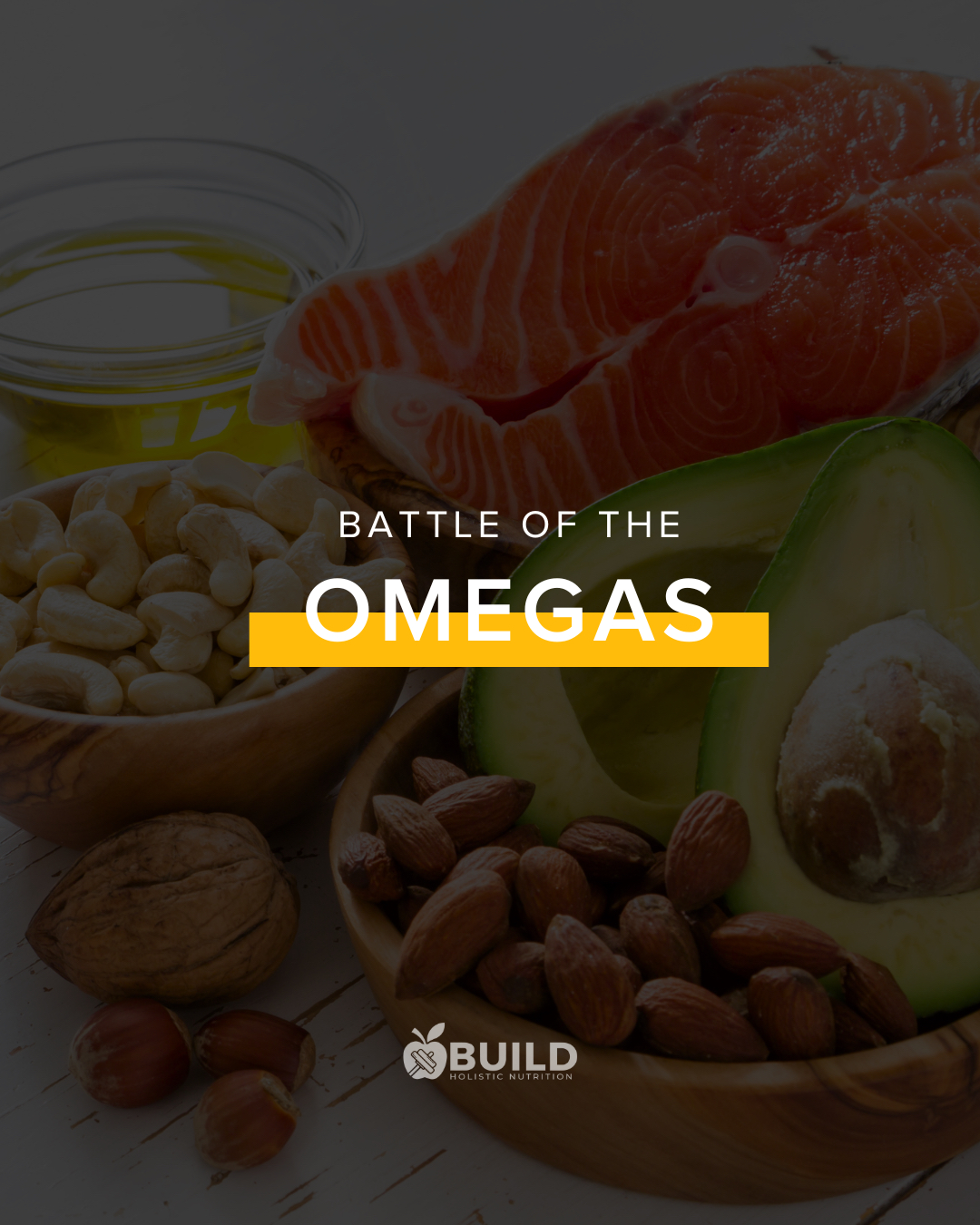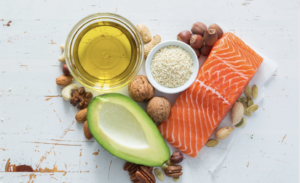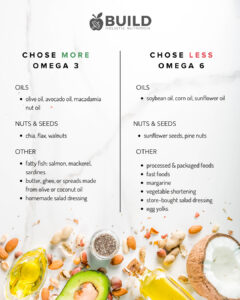October 24, 2023
What’s the difference between Omega 3 and Omega 6 fats and what foods are they found in?
Great question! Omega-3 and Omega-6 are both types of polyunsaturated fats, and they play important roles in our health. Here’s a simple breakdown:
Omega-3 Fats:
- Sources: Found in fatty fish like salmon, mackerel, and sardines, as well as in chia seeds, flaxseeds, and walnuts.
- Benefits: Omega-3 fats are known for their anti-inflammatory properties and are important for heart health, brain function, and reducing the risk of chronic diseases.
- Recommended Intake: The American Heart Association suggests eating at least two servings of fatty fish per week. For those who don’t consume fish, omega-3 supplements like fish oil can be considered.
Omega-6 Fats:
- Sources: Commonly found in oils like soybean oil, corn oil, and sunflower oil. It’s also present in nuts and seeds like sunflower seeds and pine nuts.
- Benefits: Omega-6 fats are essential for growth and development, and they support overall cell function. However, an excess of omega-6 relative to omega-3 can contribute to inflammation in the body.
- Recommended Intake: It’s important to get enough omega-6 fats, but in a balanced ratio with omega-3. The ideal ratio of omega-6 to omega-3 is debated, but aiming for a ratio of around 2:1 to 4:1 (omega-6 to omega-3) is generally recommended.
Balancing Omega-3 and Omega-6:
- Importance of Balance: Both types of fats are important, but the balance between them is crucial. In modern diets, there’s often an overabundance of omega-6 due to the widespread use of oils like soybean and corn oil in processed foods.
- Reducing Omega-6 Rich Oils: It can be helpful to reduce consumption of processed foods and switch to cooking oils with a healthier omega-6 to omega-3 ratio, like olive oil or avocado oil.
Individual Needs:
- Variation in Needs: The ideal balance of omega-3 and omega-6 can vary based on individual health, activity levels, and specific health goals. We like to see the athletes and active people we work with at Build Nutrition have a little higher omega 3 in the diets because of their increased need for anti-inflammatory support.
Click to download your handy list!
Summary: In a nutshell, both omega-3 and omega-6 fats are important for our health. Omega-3s are anti-inflammatory and found in fatty fish, chia seeds, flaxseeds, and walnuts. Omega-6s are essential for growth and found in oils like soybean and sunflower oil, as well as in nuts and seeds. Strive for a balanced intake of both, aiming for a ratio of around 2:1 to 4:1 (omega-6 to omega-3) for overall well-being. Remember, small changes in your diet can make a big difference over time!
Okay great, more omega 3 and less omega 6. How exactly can I reduce my omega 6 intake?
Another great question! Here are 10 easy ways:
- Choose Cooking Oils Wisely:
- Opt for oils with a lower omega-6 content, such as olive oil, avocado oil, or macadamia nut oil. These oils have healthier fatty acid profiles compared to oils like soybean, corn, or sunflower oil.
- Limit Processed Foods:
- Many processed and pre-packaged foods, including snacks, baked goods, and fried foods, contain oils high in omega-6. Reducing your consumption of these items can help lower your overall omega-6 intake.
- Read Food Labels:
- Check ingredient lists for oils high in omega-6, like soybean, corn, and sunflower oil. If these oils are listed near the top, consider choosing an alternative product with healthier fats.
- Minimize Fast Food and Takeout:
- Fast food restaurants often use oils with high omega-6 content for frying. When possible, opt for home-cooked meals or choose restaurants that use healthier cooking oils.
- Limit Use of Margarine and Vegetable Shortening:
- Margarine and vegetable shortening are typically made from oils high in omega-6. Consider using alternatives like butter, ghee, or spreads made from olive or coconut oil.
- Opt for Whole Foods:
- Whole, unprocessed foods like fruits, vegetables, whole grains, lean proteins, and nuts and seeds naturally contain lower levels of omega-6 fats compared to processed foods.
- Increase Omega-3-Rich Foods:
- Boost your intake of omega-3 fatty acids by incorporating more fatty fish (like salmon, mackerel, and sardines), flaxseeds, chia seeds, and walnuts into your diet. This can help balance out the omega-6 to omega-3 ratio.
- Consider Omega-3 Supplements:
- If it’s challenging to get enough omega-3s through your diet alone, you might consider omega-3 supplements like fish oil capsules. Order your omega 3s from our trusted online pharmacy Fullscript.
- Homemade Salad Dressings:
- Make your own salad dressings using olive oil or avocado oil instead of store-bought dressings, which can contain oils high in omega-6.
- Be Mindful of Cooking Methods:
- Grilling, baking, and roasting with minimal oil can be healthier alternatives to frying. When using oils for cooking, choose those with a better omega-6 to omega-3 ratio.
Did you know?
We spend an entire month talking about FATS in our lunchBOX Gamified Nutrition Challenge!
The science, the why, the performance benefits, and all the how-to’s… every day so you can build the lifelong habits you need to build your best body, from the inside out.
Check out the lunchBOX!
Battle of the Omegas (Fats)
The entire contents of this website are based upon the opinions of Build Holistic Nutrition. Please note that Build Nutrition is not a dietitian, physician, pharmacist or other licensed healthcare professional. The information on this website is NOT intended as medical advice, nor is it intended to replace the care of a qualified health care professional. This content is not intended to diagnose or treat any diseases. Always consult with your primary care physician or licensed healthcare provider for all diagnosis and treatment of any diseases or conditions, for medications or medical advice, as well as before changing your health care regimen.
© BUILD NUTRITION 2025. ALL RIGHTS RESERVED. PRIVACY POLICY
Go ahead, creep us on social. You know you want to!



